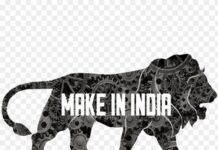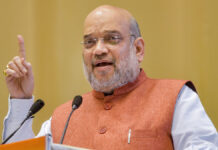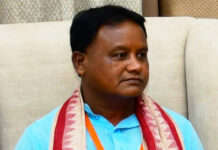The last one week has been fraught for the leaders of both BJP and Biju Janata Dal. There has been intense speculation about the revival of their alliance that broke 15 years ago ahead of 2009 elections. However, uncertainty continues with talks between the two sides getting stuck on the issue of seat sharing. Leaders, especially those in the BJP camp, have added to the confusion.
Nerve wracking suspense over the revival of Biju Janata Dal (BJD)-BJP alliance that collapsed 15 years ago continues. While there are confusing signals from the BJP with its state leaders apparently unsure of their position chief minister Naveen Patnaik has maintained stoic silence over the issue.
This is a measure of his self-confidence. His Man Friday, bureaucrat-turned-politician V Karthikeyan Pandian appears to be equally confident about BJD’s electoral prospects. A victory in the coming elections would give Patnaik a straight sixth-term in office, a record which could be the envy of any chief minister in the country.
Alliance talks gained traction following Prime Minister Narendra Modi’s one-day visit to the state on March 5. The visit saw open display of bonhomie between the two leaders who shook hands and exchanged pleasantries. The very next day senior state BJP leaders were called to Delhi and BJD leaders went into a huddle at Naveen Niwas, the residence of the chief minister who is also the president of BJD.
A formal announcement with regard to the alliance was expected on March 12 when union home minister and Modi’s right hand man Amit Shah was likely to visit the state. However, nothing of the sort happened. Neither Shah came nor was there any announcement about the alliance. The most recent statement of Shah made at an event in Delhi has added to the confusion. While union home minister did not categorically rule out the possibility of an alliance he said many important things are taken into consideration while making these decisions. He also exuded confidence about BJP doing well in Odisha in either case.
Some senior BJP leaders even asserted that there had been no discussion about an alliance in Delhi. State party president Manmohan Samal asserted that the party would contest the coming polls alone but within an hour of that he told journalists that it was his personal view and the top leadership would take a final call on the issue. The BJD leadership has chosen to keep mum over the issue.
Thus, speculation with regard to a pact between the two parties continues. Alliance talks are reported to have hit the seat sharing hurdle. “Seat sharing is a tricky issue with both sides bargaining hard. The BJP wants to contest the majority of Lok Sabha seats and also a good number of assembly seats which apparently is not acceptable to the BJD. Then there is the issue of seat selection which could turn out to be trickier than it seems. These things may take time to work out,” said a senior leader who did not wish to be identified.
The BJD presently has 12 Lok Sabha members and accounts for 112 of the 147 seats in the state assembly. The BJP, on the other hand, holds 8 Lok Sabha seats including all the 5 in western Odisha, its traditional stronghold. With 22 seats in the state assembly it also enjoys the tag of being the main opposition party which earlier belonged to the Congress which has now been reduced to just nine seats in the state assembly. The Congress has just one Lok Sabha seat–Koraput–in Odisha.
Leaders on both sides are being expectedly cautious about discussing the alliance issue in public. Within BJP there is also talk of growing discontent among the cadres over a possible alliance as the two parties have faced each other in elections as adversaries since 2009. While there is a section within the BJP which thinks that party would gain from the alliance, the cadre on the ground seem to be unhappy.
They think that the hard work done by them in several constituencies for the last five years to strengthen BJP’s base may go waste in the event of an alliance. “We cannot be sure if we will get those seats. The truth is we have been working overtime to strengthen our position across the state. The BJD was our main enemy but an alliance could change the entire equation,” said a BJP worker while admitting to the compulsions of the party’s central leadership. “The Prime Minister has given the slogan of abki baar char sau paar (let’s cross the 400 seats mark this time). For this goal to be realized some state units may have to make some compromises. But in Odisha this could have several adverse implications for us,” said a party veteran who appeared worried about the possibility of a cadre rebellion in the state in the event of an alliance.
There is no denying that the BJD-BJP alliance that came into existence in 1998, just a year after the formation of the regional party, was a success in many respects though ideologically there was little common between them. The BJD being a new party found it politically wise to join hands with the BJP which was on the upswing at the time.
The other important factor that dictated BJD’s choice of its ally was that it treated Congress as its prime enemy right from the beginning. The BJD-BJP alliance also swept to power in Odisha in 2000 on an anti-Congress plank which sought to expose the corruption and inefficiency of the incumbent Congress government which had completely mismanaged the relief and rehabilitation work in the wake of 1999 super-cyclone which had devastated the entire coastal belt of Odisha leaving more than 10,000 people dead and lakhs homeless.
So, there could be no question of aligning with the Congress and BJP became the natural ally of the regional party. The two-party coalition ran the state for nearly nine years. But for a few differences the going was smooth for the coalition until the 2008 Kandhamal communal riots happened. The violence left Patnaik worried as it threatened to dent his secular image.
The 11-year-old BJD-BJP alliance collapsed ahead of 2009 elections ostensibly over the issue of seat sharing. The two parties contested the 2009 elections separately. While BJD came to power with a comfortable majority the BJP could win just 6 seats in the state’s 147-strong assembly. It was blanked in the Lok Sabha. The 2014 elections saw the saffron party bagging 10 assembly seats and the lone Lok Sabha seat of Sundergarh.
But 2014 marked a turning point in the relations between BJD and BJP. With the BJP-led NDA coming to power at the Centre with full majority Patnaik’s relations with the central BJP leadership, especially Prime Minister Narendra Modi improved substantially. The chief minister realized the importance of having a friendly Centre to ensure the development of the state. Even though he followed an avowed policy of maintaining equidistance from BJP and Congress, he supported the NDA government on several crucial issues inside the parliament.
The trend continued. During NDA’s second term under Modi the BJD’s support for the government at the Centre was even more obvious with the party backing it on controversial issues like scrapping of article 370 and passage of Triple talaq and Citizenship Amendment bills. The BJD maintained that it had offered issue-based support to the NDA government with state and national interests in mind.
Their need for each other being mutual the bond between Patnaik and Modi became stronger and they refrained from criticizing each other even at election rallies though their parties happened to be rivals in the state politics. With elections round the corner now the possibility of an alliance between the two parties is being discussed. While the BJP needs BJD’s support mainly to ensure that its Lok Sabha tally in the state goes up which is crucial for the party to better its 2019 record the BJD is keen to retain its hold on the state.
As the wait continues it is obvious that BJD remains in an advantageous position with or without an alliance. Given Patnaik’s popularity the party led by him seems certain to sweep the polls again.





































